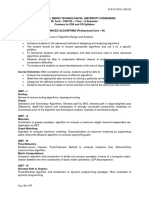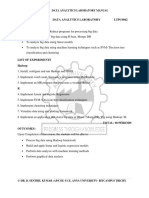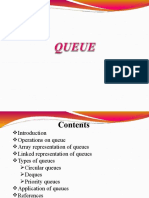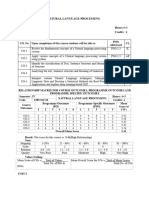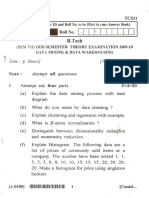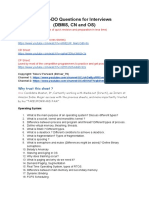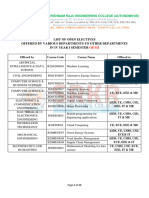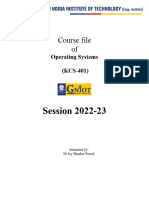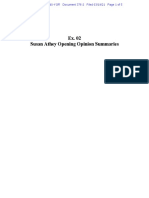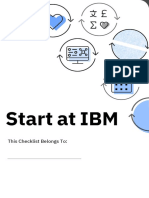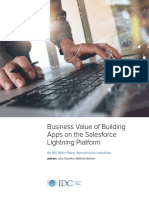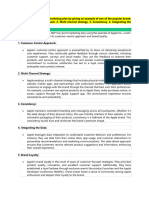FullStackWebDevelopment
Unit-I
UnderstandingtheBasicWebDevelopmentFramework:Web:
ThefullformofWWWistheWorldWideWeb.WWWisalsocalledaWeb and it is
a catalogue of an order of all websites connected to the worldwideInternet. It is an
information system in which linked hypertext data and resources are accessed over
the Internet.
In simply it refers to Websites and Web Pages or anything that works over
the internet.
Development:Referstobuildingtheapplicationfrom scratch.
WebDevelopment:
Web developmentrefers to the creating, building, and maintaining of
websites.Itincludesaspectssuchaswebdesign,webpublishing,webprogramming, and
database management. It is the creation of an application that works over the
internet i.e. websites.
WebDevelopmentcanbeclassifiedintotwoways:
• Frontend Development
Thepartofawebsitewheretheuserinteractsdirectlyistermedas
frontend. Itisalsoreferredtoasthe ‘clientside’oftheapplication.
PopularFrontendTechnologies
• HTML:HTMLstandsforHyperTextMarkupLanguage.Itisusedtodesign
thefrontendportionofwebpagesusingmarkuplanguage.Itactsasaskeleton for a
website since it is used to make the structure of a website.
• CSS:Cascading Style Sheets fondly referred to as CSS is a simply designed
language intended to simplify the process of making web pages presentable. It
is used to style our website.
• JavaScript:JavaScript is a scripting language used to provide a dynamic
behavior to our website.
• Bootstrap:Bootstrap is a free and open-source tool collection for creating
responsivewebsitesandwebapplications.ItisthemostpopularCSS
FSWD Page1.1
framework for developing responsive, mobile-first websites. Nowadays, the
websites are perfect for all browsers (IE, Firefox, and Chrome) and for allsizes
of screens (Desktop, Tablets, Phablets, and Phones).
• Bootstrap4
• Bootstrap5
BackendDevelopment
Backend is the server side of a website. It is part of the website
that users cannot see and interact with. It is the portion of software that does not
come indirectcontact withthe users.Itisused tostoreandarrange data.
PopularBackendTechnologies
• PHP:PHP is a server-side scripting language designed specifically for web
development.
• Java:Javaisoneofthemostpopularandwidelyusedprogramming languages. It
is highly scalable.
• Python:Python is a programming language that lets you work quickly and
integrate systems more efficiently.
• Node.js:Node.js is an open source and cross-platform runtime environment
for executing JavaScript code outside a browser.
Full-stackDevelopment
Typically,back-endwebsitedevelopmentandfront-enddevelopmentarecarried out by
different professionals with expertise in each.
Whenthewebsolutionisdevelopedbyasingledeveloperwhohasexperience with both
front-end and back-end, it is called full-stack development.
WebDevelopmentFramework:
A web development framework is a set of resources and tools for software
developers to build and manage web applications,web servicesand websites, as
well as to develop application programming interfaces (APIs). Web development
frameworks are also referred to as web application frameworks or simply web
frameworks.
Web development frameworks enable developers to build applications that can run
onwell-knowntechnologystackssuchas
FSWD Page1.2
theLinux,Apache,MySQLandPHP(LAMP) stack. Most frameworks provide a wide
range of features and functionality that help streamline application development.
Because web development frameworks are so comprehensive in scope, they offer
development teams several important benefits, including the following:
• Developers can build applications faster and more efficiently because they
write less code, reuse code, and contend with fewer errors and bugs.
• Many frameworks areopen sourceand backed by strong developer
communities that help to optimize the code and reduce errors, leading to better
performance and reliability, as well as easier maintenance.
• Many web development frameworks are widely used, adhere to industry
standards and are backed by strong developer communities. The continuous
vetting and improvements that this provides results in better security.
Developers also avoid many of the risks that come with building applications
from scratch.
• Web development frameworks speed up application development, reduce
errors, simplify debugging and increase reliability. Many of them are also open
source and free. Taken together, the factors can significantly reduce overall
development costs.
A web development framework also provides the foundation and system-level
services necessary to support a content management system (CMS). A content
management system is an application built on top of the development framework
that adds functionality for dynamically managing digital web content.
Whatarethewebframeworktypes?
Organizations can choose from a wide range of web development frameworks --
each offering an assortment of features -- giving development teams plenty of
options from which to choose. Despite their differences, however, most
frameworksfallinto oneof twocategories: those that targetfront-end development
and those that target the back end:
FSWD Page1.3
• Front-endframeworks.Also called user-side or client-side frameworks,
front-end frameworks focus on the user-facing elements of a web application.
They provide the components and templates necessary to render passive or
interactivewebpagesinabrowser,usingindustrytechnologiessuch as HTML, CSS,
JavaScriptand jQuery.
• Back-endframeworks. These frameworks, also called server-side
frameworks, target the server and back-end components that support a web
application. They're responsible for mapping URLs, processingHTTPrequests,
interfacing with data sources and supporting other back-end operations. Back-
endframeworksuseindustrytechnologiessuchas Python,PHP,.NET,Java and
Ruby.
NPM stands for Node Package Manager. It's a registry and package manager for JavaScript
Software packages.
Yarn is an established open-source package manager used to manage dependencies in JavaScript
projects. It assists with the process of installing, updating, configuring, and removing packages
dependencies, eventually helping you reach your objectives faster with fewer distractions .
FSWD Page1.4
Web development frameworks are also distinguished from each other by their
approach toapplication architecture. Many web development frameworks arebased
on a Model-View-Controller (MVC) architecture, which separates the web
application into three layers.
▪ TheModellayerisconcernedwiththeback-endbusinesslogicand data.
▪ TheViewlayerfocusesontheuserinterfaceandfacilitatinginteractivity.
▪ TheControllerlayer acts as aninterface between the modeland view layers,
processing the requests between them.
ComponentsofWebDevelopment:
o Applicationtemplatesforpresentinginformationwithina browser.
o Programmingenvironmentforscriptingtheflowofinformation.
o APIsforaccessingback-enddataresources
o Codelibrarieswithprebuiltcomponentsandcodesnippets.
o Supportfordebugging,qualityassurance(QA)testingandcodereusability.
FSWD Page1.5
Benefits of Web Development Framework:
Makes the Development Process Easier
Webframeworksprovidepre-writtencodelibraries,modules,andguidelinestodevelopers,whichcan
greatlyacceleratethecreationprocess.Assuringscalability,maintainability,andadherencetoindustry
norms for the code also helps.
EasesDebuggingandApplicationMaintenance
Web frameworks give programmers accesstotools thatsimplify managing anddebuggingtheirweb
applications.Frameworksfrequentlycomewithbuilt-indebuggingtoolandcanidentifyandcorrect typing errors
and bugs.
ReducesCodeLength
With the aid of web frameworks, developers can achieve more with less code. Pre-built libraries and
modulescanspeedupdevelopmentbysavingdeveloperstimeandloweringtheamountofcodetheyneed to create.
ImprovesDatabaseProficiency
Web frameworks often include built-in tools for database integration, making it easier to work with
databases.Thiscanhelpimprovedatabaseproficiency,whichisessentialforwebapplicationsthatrelyon data.
ReinforcesSecurity
Web frameworks provide developers with built-in security features and guidelines to help reinforce
securitybestpractices.Thishelpsensurethatwebapplicationsaresecureandlessvulnerabletoattacks.
FSWD Page1.6
Users
USER:
WebApplication
A web application is software that runs in your web browser. Businesses have to
exchange information and deliver services remotely. They use web applications to
connect with customers conveniently and securely. The most common website
featureslikeshoppingcarts,productsearchandfiltering,instantmessaging,andsocial media
newsfeeds are web applications in their design. They allow you to access complex
functionality without installing or configuring software.
Benefitsofwebapplications
Web applications have several benefits, with almost all major enterprises utilizing
them as part of their user offerings. Here are some of the most common benefits
associated with web apps.
1. Accessibility
Web apps can be accessed from all web browsers and across various personal and
business devices. Teams in different locations can access shared documents, content
management systems, and other business services through subscription-based web
applications.
2. Efficientdevelopment
As detailed, the development process for web apps is relatively simple and cost-
effective for businesses. Small teams can achieve short development cycles, making
web applications an efficient and affordable method of building computer programs.
In addition, because the same version works across all modern browsers and devices,
you won't have to create several different iterations for multiple platforms.
3. Usersimplicity
Web apps don't require users to download them, making them easy to access while
eliminating the need for end-user maintenance and hard drive capacity. Web
applications automatically receive software and security updates, meaning they are
always up to date and less at risk of security breaches.
FSWD Page1.7
4. Scalability
Businesses using web apps can add users as and when they need, without additional
infrastructure or costly hardware. In addition, the vast majority of web application
data is stored in the cloud, meaning your business won't have to invest in additional
storage capacity to run web apps.
Somecommonwebapplications
There are numerous types of web applications. Here are some of the most well-
known.
• Workplacecollaborationwebapplications
Workplace collaborationweb apps allow team members to access documents, shared
calendars, business instant messaging services, and other enterprise tools.
❖ Ecommercewebapplications
Ecommerceweb apps such as Amazon.comenable users to browse, search, and pay for
products online.
❖ Emailwebapplications
Webmail appsare widely used by enterprises and personal users to access theiremails.
They often include other communication tools such as instant messaging and video
meetings.
❖ Onlinebankingwebapplications
Business and personal users widely use online banking web apps to access their
accounts and other financial products such as loans and mortgages.
❖ Technicaldocumentation
You can use web applications to create and share technical documentation like user
manuals, how-to guides and device specifications
WebServer
The termwebservercan refer to hardware or software, or both of them working
together.
1. On the hardware side, a web server is a computer that stores web server
software and a website's component files (for example, HTML documents,
images, CSS stylesheets, and JavaScript files).Aweb server connects to the
FSWD Page1.8
Internetandsupportsphysicaldatainterchangewithotherdevicesconnected to
the web.
2. On the software side, a web server includes several parts that control how
web users access hosted files. At a minimum, this is an HTTPserver. An
HTTPserverissoftwarethatunderstands URLs(webaddresses) andHTTP(the
protocol your browser uses to view webpages). An HTTP server can be
accessed through the domain names of the websites it stores, and it delivers
the content of these hosted websites to the end user's device.
At the most basic level, whenever a browser needs a file that is hosted on a web
server, the browser requests the file via HTTP. When the request reaches the
correct (hardware) web server, the (software) HTTPserveraccepts the request,
findstherequesteddocument,andsendsitbacktothebrowser,alsothroughHTTP. (If the
server doesn't find the requested document, it returns a 404response instead.)
Topublishawebsite,youneedeitherastaticoradynamicweb server.
Astaticwebserver, or stack, consists of a computer (hardware) with an HTTP
server (software). We call it "static" because the server sends its hosted files as-is
to your browser.
Adynamicwebserver consists of a static web server plus extra software, most
commonly anapplicationserverand adatabase. We call it "dynamic" because the
application server updates the hosted files before sending content to your browser
via the HTTP server.
FSWD Page1.9
WebBrowser
A software application used to access information on the World Wide Web
is called a Web Browser. When a user requests some information, the web browser
fetches the data from a web server and then displays the webpage on the user's
screen.
TypesofWebBrowser
Thefunctionsofallwebbrowsersarethesame.Thus,morethanthedifferenttypes there
are different web browsers which have been used over the years.
Discussed below are different web browser examples and their specific features:
1. WorldWideWeb
• The first web browser ever
• Launched in 1990
• It was later named “Nexus”to avoid any confusion with the World Wide
Web
• Had the very basic features and less interactive in terms of graphical
interface
• Did not have the feature of book mark
2. Mosaic
• It was launched in 1993
• These cond web browser which was launched
• Had a better graphical interface .Images, text and graphics could all be
integrated
• It was developed at the National Center for Super computing Applications
• Theteam which was responsible for creating Mosaic was lead by
MarcAndreessen
• It was named “the world’s first popular browser”
3. NetscapeNavigator
• It was released in 1994
• In the 1990s, it was the dominant browser in terms of usage share
• More versions of this browser were launched by Netscape
FSWD Page1.10
It had an advanced licensingschemeandallowedfreeusagefornon-
commercial purposes
4. InternetExplorer
• Itwaslaunchedin1995by Microsoft
• By2003,almost95%ofusageshareandhadbecomethe most popular
browsers of all
• Closeto10versionsofInternetExplorerwerereleasedbyMicrosoftand were
updated gradually
• ItwasincludedintheMicrosoftWindowsoperatingsystem
• In2015,itwasreplacedwith“MicrosoftEdge”,asitbecamethedefault
browser on Windows 10
5. Firefox
• Itwasintroducedin2002andwasdeveloped byMozilla Foundation
• FirefoxovertooktheusagesharefromInternetExplorerandbecamethe
dominant browser during 2003-04
• Location-awarebrowsingwasmadeavailablewith Firefox
• Thisbrowserwasalsomadeavailableformobilephones,tablets,etc.
6. GoogleChrome
• Itwaslaunchedin2008by Google
• Itisacross-platformwebbrowser
• Multiplefeaturesfromoldbrowserswereamalgamatedtoformbetterand
newer features
• Tosavecomputersfrommalware,Googledevelopedthead-blockingfeature to
keep the user data safe and secure
• Incognitomodeisprovidedwhereprivatesearchingisavailablewhereno
cookies or history is saved
• Tilldate,ithasthebestuser interface
Apart from these, Opera Mini web browser was introduced in 2005 which was
specially designed for mobile users. Before the mobile version, the computer
version “Opera” was also released in 1995. It supported a decent user interface and
was developed by Opera Software.
FSWD Page1.11
S.
No. Parameters WebBrowser WebServer
Web Browseris an
Application program that A web serveris a program or
displays a World wide web the computer that provide
1. Basics
document. It usually usesthe services to other programs
internet service to access the called client.
document.
The Web server accepts,
TheWebbrowserrequests the approves, and responds to the
2. Function server for the web request made by the web
documents and services. browser for a web document or
service.
A web browser is a
The web server is responsible
programme that uses
3. Responsibility for connecting websites and
websites to search the
web browsers.
internet for information.
The web server is a software or
The web browser acts as an
a system which maintain the
interface between the server
4. Interface web applications, generate
and the client and displays a
response and accept
web document to the client.
clientsdata.
Components of web Components of web server
Componentsofar browser architecture- a architecture- hardware,
5.
chitecture controller, clientprogram, operating system software, and
and interpreters. Web server software.
The web browser sends an Theweb server gets HTTP
HTTPrequestan
6. HTTP request and gets an requests and sends HTTP
dresponse
HTTP response. responses.
There exist three types of
Doesn’t exist any
ProcessingMode processing models for web
7. processing model for the
l servers i.e Process-based,
web browser.
Thread based, and Hybrid.
8. Storingdata Webbrowserstoresthe Webserversprovideanareato
FSWD Page1.12
S.
No. Parameters WebBrowser WebServer
cookiesfordifferentwebsites. store and organize the pages of
the website.
The web server can be a
remote machine placed on the
The web browser is
other side of your network or
9. Installation installedontheclient’s
even on the other end of the
computer.
globe, or it is your very own
personal computer at home.
Examples of Web browsers
are Mozilla Firefox, Google AnexampleofaWeb Serveris
10. Examples
Chrome, and Internet Apache Server.
Explorer.
MVCArchitecture:
MVC is an architectural pattern that is used to divide the application into
three components, namely - Model, View, and Controller. Separating the
application into these three components makes it easier to scale the application and
makes it more extensive and easier to maintain.
FeaturesofMVC:
• Itprovidesaclearseparationofbusinesslogic,Ullogic,andinputlogic.
• ItoffersfullcontroloveryourHTMLandURLswhichmakesiteasyto design web
application architecture.
• ItisapowerfulURL-mappingcomponentusingwhichwecanbuild applications
that have comprehensible and searchable URLs.
• ItsupportsTestDrivenDevelopment(TDD).
FSWD Page1.13
ComponentsofMVC:
TheMVCframeworkincludesthefollowing3components:
Controller:
• The controller is the component that enables the interconnection
betweentheviewsandthe modelsoit actsasan intermediary. The
controller doesn’t have to worry about handling data logic, it
justtellsthemodelwhattodo.Itprocessallthe businesslogic
andincomingrequests,manipulatedatausing the Model
componentandinteractwiththe View torenderthe final output.
View:
• The View componentisusedforalltheUIlogicofthe application. It
generates a user interface for the user. Views are createdby
thedatawhich iscollectedbythe modelcomponent but these data
aren’t taken directly but through the controller. It only interacts
with the controller.
Model:
• The Model component corresponds to all the data-related logicthat
the user works with. This can represent either the data that is being
transferred between the View and Controller components or any
other business logic-related data. It can add or retrieve data from
the database. It responds to the controller’s request because the
controller can’t interact with the database by itself. The model
FSWD Page1.14
interacts with the database and gives the required data back to the
controller.
AdvantagesofMVC:
• Codesareeasytomaintainandtheycanbeextendedeasily.
• TheMVCmodelcomponentcanbetestedseparately.
• ThecomponentsofMVCcanbedevelopedsimultaneously.
• It reduces complexity by dividing an application into three units.
Model,view,andcontroller.
• ItsupportsTestDrivenDevelopment(TDD).
• It works well forWeb apps that are supported by large teams of web
designers and developers.
• Thisarchitecturehelpstotestcomponentsindependentlyasallclassesand
objectsareindependentofeachother
• SearchEngineOptimization(SEO)Friendly.
DisadvantagesofMVC:
• Itisdifficulttoread,change,test,andreusethismodel
• Itisnotsuitableforbuildingsmallapplications.
• Theinefficiencyofdataaccessinview.
• The framework navigation can be complex as it introduces new layers of
abstraction which requires users to adapt to the decomposition criteria of MVC.
• IncreasedcomplexityandInefficiencyofdata
PopularMVCFrameworks:
SomeofthemostpopularandextensivelyusedMVCframeworksarelistedbelow.
• RubyonRails
• Django
• CherryPy
• SpringMVC
• Catalyst
• Rails
• ZendFramework
• FuelPHP
• Laravel
• Symphony
UnderstandingofDifferentStack:Express
FSWD Page1.15
The Express module acts as the webserver in the Node.js-to-Angular stack.
The fact that it is running in Node.js makes it easy to configure, implement, and
control. The Express module extends Node.js to provide several key components
for handling web requests.
This allows you to implement a running webserver in Node.js with only a
few lines of code. For example, the Express module provides the ability to easily
set up destination routes (URLs) for users to connect to.
It also provides great functionality on working with the HTTP request and
responseobjects,includingthingslikecookiesandHTTPheaders.Thefollowingis a
partial list of the valuable features of Express:
■ Route management: Express makes it easy to define routes (URL
endpoints) that tie directly to Node.js script functionality on the server.
■ Errorhandling:Expressprovidesbuilt-inerrorhandlingfordocumentsnot
found and other errors.
■ Easy integration:An Express server can easily be implemented behind an
existing reverse proxy system such as Nginx or Varnish. This allows it to be easily
integrated into your existing secured system.
■ Cookies:Expressprovideseasycookie management.
■ Sessionandcachemanagement:Expressalsoenablessessionmanagement and
cache management.
Angular
Angular is a client-side framework developed by Google. Angular provides
all the functionality needed to handle user input in the browser, manipulate data on
the client side, and control how elements are displayed in the browser view. It is
written using TypeScript.
The entire theory behind Angular is to provide a framework that makes it
easy to implement web applications using the MVC framework.
Other JavaScript frameworks could be used with the Node.js platform, such
as Backbone, Ember, and Meteor.
However, Angular has the best design, feature set, and trajectory at this
writing.
HerearesomeofthebenefitsofAngular:
■ Data binding:Angular has a clean method to bind data to HTMLelements
using its powerful scope mechanism.
■ Extensibility:TheAngular architecture allows you to easily extend almost
every aspect of the language to provide your own custom implementations.
■ Clean:Angularforcesyoutowriteclean,logicalcode.
■ Reusable code: The combination of extensibility and clean code makes it
easy to write reusable code inAngular. In fact, the language often forces you to do
so when creating custom services.
FSWD Page1.16
■ Support: Google is investing a lot into this project, which gives it an
advantage over other similar initiatives.
■ Compatibility: Angular is based on TypeScript, which makes it easier to
begin integrating Angular into your environment and to reuse pieces of your
existing code within the structure of theAngular framework.
Node.js
Node.js is a development framework based on Google’s V8 JavaScript
engine. Therefore, Node.js code is written in JavaScript and then compiled into
machine code by V8 to be executed.
Many of your backend services can be written in Node.js, as can the server-
side scripts and any supporting web application functionality. The nice thing about
Node.js is that it is all just JavaScript, so you can easily take functionality from a
client-side script and place it in a server-side script.
Also, the web server can run directly within the Node.js platform as a
Node.js module, so it makes it much easier than, say, Apache at wiring up new
services or server-side scripts.
The following are just a few reasons why Node.js is a great framework to
start from:
■ JavaScript end-to-end: One of the biggest advantages to Node.js is that it
allows you to write both server- and client-side scripts in JavaScript. There have
always been difficulties in deciding where to put scripting logic. Too much on the
client side makes the client cumbersome and unwieldy, but too much on the server
side slows down web applications and puts a heavy burden on the webserver.With
Node.js you can take JavaScript written on the client and easily adapt it for the
server and vice versa. Also, your client developers and server developers will be
speaking the same language.
■ Event-driven scalability: Node.js applies a different logic to handling web
requests.Ratherthanhavingmultiplethreadswaitingtoprocesswebrequests,they are
processed on the same thread using a basic event model. This allows Node.js
webserverstoscaleinwaysthattraditionalwebserversnevercan.Thisisdiscussed in
more detail in later chapters.
■ Extensibility: Node.js has a great following and an active development
community.NewmodulestoextendNode.jsfunctionalityarebeingdevelopedall
FSWD Page1.17
the time.Also it is simple to install and include new modules in Node.js, making it
easy to extend a Node.js project to include new functionality in minutes.
■ Time: Let’s face it, time is valuable. Node.js is super easy to set up and
develop in. In only a few minutes, you can install Node.js and have a working
webserver.
MongoDB
MongoDB is an agile and scalable NoSQL database. The name Mongo
comes from “humongous.”
It is based on the NoSQLdocument store model, meaning that data is stored
in the database as a form of JSON objects rather than the traditional columns and
rows of a relational database.
MongoDB provides great website backend storage for high traffic websites
that need to store data such as user comments, blogs, or other items because it is
fast, scalable, and easy to implement.
This book covers using the MongoDB driver library to access MongoDB
from Node.js. Node.js supports a variety of DB access drivers, so the data store
could just as easily be MySQLor some other database. However, thefollowingare
some of the reasons that MongoDB really fits in the Node.js stack well:
■ Document orientation: Because MongoDB is document-oriented, the data
is stored in the database in a format close to what you will be dealing with in both
server-side and clientside scripts. This eliminates the need to transfer data from
rows to objects and back. Understanding the Node.js-to-Angular Stack
Components 13
■ High performance: MongoDB is one of the highest performing databases
available. Especiallytodaywhenmoreandmorepeopleinteractwithwebsites,itis
important to have a backend that can support heavy traffic.
■ Highavailability:MongoDB’sreplicationmodelmakesiteasytomaintain
scalability while keeping high performance.
■ High scalability: MongoDB’s structure makes it easy to scale horizontally
by sharing the data across multiple servers.
FSWD Page1.18
■ No SQL injection: MongoDB is not susceptible to SQL injection (putting
SQL statements in web forms or other input from the browser that compromisesthe
DB security) because objects are stored as objects, not using SQLstrings.
React
React anchors the MERN stack. In some sense, it is the defining component
of the MERN stack.
React is an open-source JavaScript library maintained by Facebook that can
be used for creating views rendered in HTML.
UnlikeAngularJS,Reactisnotaframework.Itisalibrary.Thus,itdoesnot, by
itself, dictate a framework pattern such as the MVC pattern.
FSWD Page1.19
ClickonSubject/
PaperunderSemestertoenter. EnvironmentalScienc
ProfessionalEnglish es
ProfessionalEnglis andSustainability-
h- I - HS3152 -II-HS3252 DiscreteMathematic GE3451
s- MA3354
Statistics and TheoryofComputation
Matricesand
NumericalMethod Digital Principles - CS3452
1stSemeste
Calculus s- MA3251 and
3rdSemest
- MA3151 ComputerOrganizat
4thSemest
ArtificialIntelligen
2ndSemest
EngineeringGraphi ion ce
EngineeringPhysi cs - CS3351 andMachineLearni
cs- PH3151 ng
- GE3251
FoundationofDa - CS3491
ta Science -
EngineeringChemi Physics for CS3352
InformationScien DatabaseManagement
stry
er
er
System - CS3492
r
er
ce
- CY3151 DataStructuresand
- PH3256
Algorithms-CD3291 WebEssentials-
Basic Electrical and IT3401
Problem Solving ElectronicsEngineeri
and ng- BE3251 Object Oriented
PythonProgrammi Programming- Introduction to
ng- GE3151 ProgramminginC- CS3391 OperatingSystem
s- CS3451
CS3251
ComputerNetworks-
CS3591
Object Oriented
FullStackWeb SoftwareEngineerin HumanValuesand
Development-IT3501 g- CCS356 Ethics - GE3791
5thSemest
7thSemest
8thSemest
6thSemest
OpenElective OpenElective2 ProjectWork/
DistributedComputi
Intership
ng
-1Elective- OpenElective3
- CS3551
3Elective- Open Elective
EmbeddedSystemsa
er
er
er
er
ndIoT - CS3691 4Elective-
4ManagementEle
Elective1 5Elective-6
ctive
Elective2
AllComputerEnggSubject [B.E.,M.E., ] (Click onSubjectstoenter)
s-
ProgramminginC ComputerNetworks OperatingSystems
ProgrammingandData ProgrammingandData ProblemSolvingandPyt
StructuresI StructureII hon
Programming
DatabaseManagementSyste ComputerArchitectur AnalogandDigitalC
ms e ommunication
DesignandAnalysisof Microprocessorsand ObjectOrientedAnalysis
Algorithms Microcontrollers andDesign
SoftwareEngineering DiscreteMathematic InternetProgramming
s
TheoryofComputation ComputerGraphics DistributedSystems
MobileComputing CompilerDesign DigitalSignalProcessing
ArtificialIntelligence SoftwareTesting GridandCloudComputin
g
DataWareHousingandData CryptographyandN ResourceManageme
Mining etworkSecurity ntTechniques
ServiceOrientedArchitectur EmbeddedandRealTi Multi-
e meSystems CoreArchitectures
and Programming
ProbabilityandQueueingThe PhysicsforInformation TransformsandPartial
ory Science DifferentialEquations
TechnicalEnglish EngineeringPhysics EngineeringChemistry
EngineeringGraphics TotalQuality ProfessionalEthicsin
Management Engineering
BasicElectricalandElectroni ProblemSolvingand EnvironmentalScience
csand Measurement PythonProgrammin andEngineering
Engineering g
